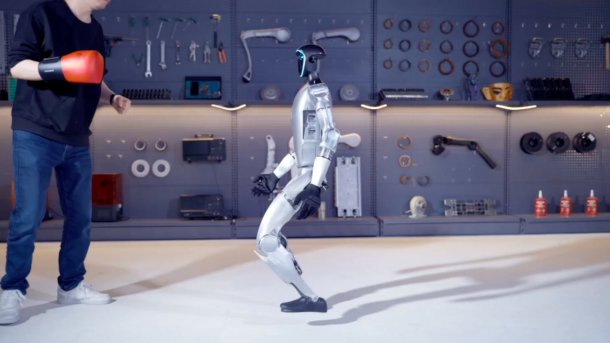Humanoid robot Unitree G1 costs 16,000 dollars
Unitree can keep the manufacturing costs for its G1 robot low and therefore offer it at a reasonable price. It is nevertheless agile and intelligent.

The G1 robot is about to be punched in the face.
(Image: Unitree Robotics)
Chinese robotics company Unitree Robotics has unveiled the Unitree G1, the first affordable humanoid general-purpose robot, at the ICRA 2024 robotics conference currently underway. It is just 1.27 m tall and the basic version is expected to cost 16,000 US dollars. This means that Unitree is offering a more affordable version of its larger, 1.8 m tall humanoid robot H1, which has already demonstrated its skills in several videos. The Unitree H1 costs from 90,000 US dollars.
Although the G1 is small at 1.27 m tall, its weight of 35 kg (including battery) is only slightly less than that of the H1 at 47 kg. The G1 robot is driven by servomotors specially developed by Unitree, with a maximum torque of 120 Nm.
The robot has a maximum of 43 degrees of freedom in its neck, limbs, hands, feet and hips. This allows it to move similarly to the current Atlas robot from Boston Dynamics, as a video shows. The robot can run at a maximum speed of 2 m/s (equivalent to 7.2 km/h). However, some of the degrees of freedom are optional, such as a degree of freedom in the wrists. These are reserved for the more expensive G1 Edu model, the price of which Unitree will only reveal on request.
The same applies to the hands, which are equipped with three force-controlled fingers. Equipped with an optional tactile sensor array, the G1 can then handle objects even more sensitively. In the video, it wears gloves with five fingers.
For orientation, the humanoid robot uses 3D lidar in the form of Livox Mid360 modules, which are supported by an Intel RealSense D435 depth camera. The camera and lidar modules are housed in the head. The G1 is powered by an 8-core "high-performance CPU". Unitree does not reveal exactly which processor is behind this. The Edu version can be optionally equipped with an Nvidia Orin controller, so that more computing power is available for more demanding tasks. The necessary energy comes from a 9000 mAh battery, which can be replaced. It keeps the robot alive for around two hours.
Not a humanoid robot for heavy work
The G1 can carry weights of up to 2 kg. That's not very much. At least not if it is to do heavy work for people in industry. However, the sensitive equipment of the hands indicates that the robot's focus is more likely to be on assembly work.
Empfohlener redaktioneller Inhalt
Mit Ihrer Zustimmmung wird hier ein externes YouTube-Video (Google Ireland Limited) geladen.
Ich bin damit einverstanden, dass mir externe Inhalte angezeigt werden. Damit können personenbezogene Daten an Drittplattformen (Google Ireland Limited) übermittelt werden. Mehr dazu in unserer Datenschutzerklärung.
To make this possible, Unitree has equipped it with a certain level of intelligence and AI learning ability. This enables it to learn new skills to complete its tasks through imitation and reinforcement learning (RL). With the Unitree Robot Unified Large Model (UnifoLM), the robot world model can be extended and its "intelligence" expanded, Unitree promises.
Unitree also reveals the secret of why the G1 robot can be offered at such a low price: "For example, we reduce the number of wires and cables, the number of chips, the number of screws, and so on. These points may seem simple, but they are actually very critical and important."
However, the G1 is not a replacement for the H1 robot. The H1 remains the top model, says Unitree. The H1 robot is stronger and more powerful.
(olb)